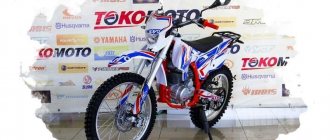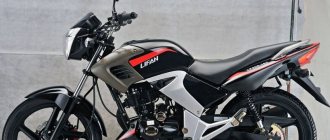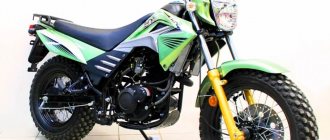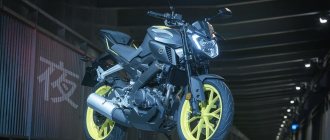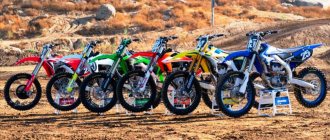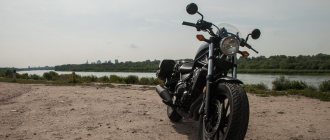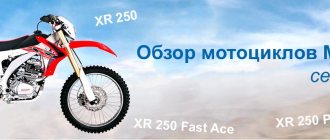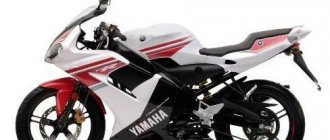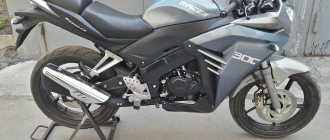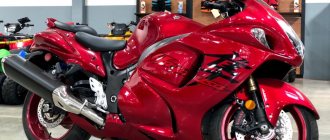RU-MOTO rating
- Reliability
- Chassis
- Appearance
- Comfort
3.8
Verdict
Bars Dakar is a reliable (by Chinese standards) and inexpensive motorcycle for beginner motorcyclists who prefer riding on rough terrain.
Bars Dakar 250 is one of the most successful light class motorcycles in terms of price-quality ratio. The reason for this ratio is more due to the price, since the quality is not the best, more on that below.
Design
This model looks discreet, but enduro is usually chosen not for its pretty appearance, but for its technical characteristics. However, if you take a closer look, everything is in order with the design of the Dakar 250 - the tucked tail, significantly raised engine and compact front end create a feeling of aggressiveness and swiftness. Its main advantage is probably that it looks like an “adult” and a solid motorcycle, and not a “Chinese knockoff”.
Competitors
By price
Compared to equipment of the same price category, for example Stels 250 Enduro or Baltmotors Enduro 250 DD, the bike has a more reliable engine and frame, as well as a more stylish aggressive design.
Photo of Stels 250 Enduro. Profile view.
Photo Baltmotors Enduro 250 DD. Profile view.
By class
In terms of its characteristics, it can be put on a par (but it’s better not to do this) with cars of a higher class - Honda XR 230, Kawasaki KLX250 or Kawasaki kx250f 2014, which cost 2 times more. The Bars Dakar 250 is in no way superior to its Japanese counterparts.
Honda XR 230. Profile photo.
Profile photo of the 2014 kx250f motorcycle.
Read other motorcycle reviews Great review of the Stels Enduro 250 motorcycle
Kawasaki KLX250. Profile photo.
Specifications
The Dakar 250 costs noticeably more than its Chinese classmates, but is still cheaper than any “Japanese” or “European”. This is not the greed of the manufacturer and dealers, no - this bike is equipped simply superbly, given its overall budget, so the high price is completely justified.
Engine
's 250cc, 4-stroke, 4-valve engine is a collaboration between Chinese and Italian engineers, and it's very good. The engine is distinguished by confident traction throughout the entire rev range, and it does not need to be desperately “twisted” to obtain decent dynamics. Power reaches 19.3 hp. , and torque – 23 Nm . The engine is powered by an injector, so the quality of the fuel being poured matters. The maximum speed on the road is 140 km/h , but driving in this mode for a long time is not recommended so as not to damage the engine.
Transmission
Baltmotors Dakar 250 is equipped with a modern 6-speed gearbox . It behaves exactly as you'd expect from a hard enduro - the gears are short, all except sixth, and you'll be using them all all the time. They shift easily, without effort or any knocks from the depths of the gearbox, which is not typical for Chinese motorcycles.
Chassis and brakes
In order to reduce weight, the frame and pendulum were made not of steel, but of aluminum , in addition, the motorcycle was equipped with fully adjustable suspensions - an inverted fork at the front and a monoshock absorber and Pro-Link at the rear. The range of settings is wide, and the strokes are quite long. Ground clearance of 330 mm allows you not to be afraid of bumps, holes and other obstacles, and disc brakes (one 240 mm disc on both wheels) stop the motorcycle effectively even at high speed. Torque is transmitted to the rear wheel via a sealless chain.
Electronics
All electronic components are made in China, but this is “ good China ”. In the owner reviews there is no information at all about any malfunctions with electronics, and this seems to be true. Moreover, in the whole design there is nothing more complicated than an injector and an LED headlight (very good, by the way!).
Weight and dimensions
The weight of the BM 250 Dakar is only 135 , which is comparable to the weight of its Japanese counterparts. This is thanks to the lightweight chassis, and such a low weight has a positive effect on dynamics and braking distance. The dimensions of the motorcycle are decent, and the seat height reaches 920 mm, so it will be difficult for short-legged pilots to reach the ground with their feet. At the same time, due to the compressed and collected fit, sitting in one position for a long time will be uncomfortable for everyone.
Controllability
As befits an off-road “rogue”, the creation of the Baltmotors company is controlled easily and naturally , this bike is able to easily cope with ruts and take sharp turns, throwing dirt from under the wheels. But all these advantages are fully manifested only in its element, that is, off-road. On asphalt roads, directional stability leaves much to be desired, and the “toothy” tires don’t help it either.
Fuel consumption
When driving on the highway, gasoline consumption does not exceed 3.5 liters per 100 km , but who would buy a Dakar 250 to drive on asphalt? So off-road the numbers will be completely different, much higher, but by how much depends on your driving style. The volume of the gas tank is small, only 8 liters , and it is better to fill it with AI-95. At least that's what the manufacturer recommends.
The story is about how I bought, learned to ride, broke and repaired the Chinese enduro Geon Dakar 250R over two seasons.
This post shows what the owner of this motorcycle will encounter when using it, what “childhood diseases” of the motorcycle need to be eliminated, who this motorcycle is suitable for and who it is not. Having looked through the BP I did not find any experience in operating this motorcycle, so I will be the first. Due to a limited budget, I could afford either a fresh Chinese enduro or a Japanese motorcycle from the early nineties. What did you have to choose? Novelty_and_design or proven_and_reliability? Like all newcomers, I was seduced by the beautiful picture and the reluctance to drive “old junk”, but the result was... well, read more about that. As I wrote in my first post, in November 2013, with a mileage of 7.8 t.km. I bought a Chinese enduro Geon Dakar 250r. Initially I wanted a road bike, but in 2013 winter suddenly began in September, and the thought of another season without a motorcycle drove me crazy. The road equipment had already been purchased in the summer and was awaiting the purchase of a motorcycle. Somewhere on the forums I found and remembered the phrase of one smart person that on an endurike you learn not only to ride, but also to fall, which you cannot afford on a city motorcycle, and together with the fact that you can ride it all year round, I began watch this particular class of off-road equipment for training. After some deliberation, it was decided to take an endurik first, and after a season switch to a road bike with a higher cubic capacity. An additional incentive was that I live five minutes from the city border, beyond which there is a large forest, so there was a place to knead the dirt.
Having looked through the BP I did not find any experience in operating this motorcycle, so I will be the first. Due to a limited budget, I could afford either a fresh Chinese enduro or a Japanese motorcycle from the early nineties. What did you have to choose? Novelty_and_design or proven_and_reliability? Like all newcomers, I was seduced by the beautiful picture and the reluctance to drive “old junk”, but the result was... well, read more about that. As I wrote in my first post, in November 2013, with a mileage of 7.8 t.km. I bought a Chinese enduro Geon Dakar 250r. Initially I wanted a road bike, but in 2013 winter suddenly began in September, and the thought of another season without a motorcycle drove me crazy. The road equipment had already been purchased in the summer and was awaiting the purchase of a motorcycle. Somewhere on the forums I found and remembered the phrase of one smart person that on an endurike you learn not only to ride, but also to fall, which you cannot afford on a city motorcycle, and together with the fact that you can ride it all year round, I began watch this particular class of off-road equipment for training. After some deliberation, it was decided to take an endurik first, and after a season switch to a road bike with a higher cubic capacity. An additional incentive was that I live five minutes from the city border, beyond which there is a large forest, so there was a place to knead the dirt.
Monitoring advertisements for sale yielded links to 5 approximately identical motorcycles. After viewing several “dockless” options, I went to look at this example. The seller was a guy about 28 years old, he said that he drove it around the city for 1 season. I liked the condition, although the rear suspension was a little damaged, but I decided not to bother and take it. I’ll say right away that at that time I didn’t have a single acquaintance who rode a motorcycle and could help with the choice, nor did I know a motorcycle mechanic. Not like now...
“Buns” that were installed on the motorcycle by the previous owner:
- rubber retainer (so-called shoe) for driving at low pressure;
- new radiators from Honda, since almost all owners leak after a year of operation;
- thermal bandage on the exhaust pipe - so as not to burn your leg
- The side plastic is covered with “Metal Mulisha” vinyl film
This motorcycle model is similar to the Honda NC 250, and is also identical to the Baltmotors Dakar (and possibly Racer RC250XZR, Kayo T6), so my experience may also be useful for their owners. (For example, on the Baltmotors website it is stated that “The model is the result of a technical partnership between Baltmotors and the Geon Engineering team (Odessa). The 2014 Dakar 250 represents the 4th generation of the model. Since the first sports use of the motorcycle at the end of 2011 Serious work has been done to find structurally correct components, ensure stable performance, testing and modernization.” It is only necessary to clarify that Baltmotors began making its Dakar model from the next (relative to mine) generation of Geon motorcycles, in which some childhood illnesses and shortcomings were eliminated.
Dimensions . Seat height: 920 mm, ground clearance: 320 mm. Since I studied at a cross-country motorcycle school on a Honda CRF250F, I am no stranger to a high saddle. Although the Dakar is lower in seating than the Japanese, its geometry is such that for me, with my height of 174 cm, it was really big. It’s tiring to ride in a standing position - either you’re not holding on to the narrowest part of the seat with your knees, or you’re reaching forward towards the steering wheel. I compared it with the Yamaha WR250, Suzuki DR200, Djebel, and all of them were more convenient for me. Thus, I recommend it for a rider with a height of 180+ cm. As an option, I would have to buy spacers for the handlebars to make it taller and tilt it closer to me, but I don’t think that for me this would change the stance dramatically. The weight of the motorcycle with fluids is about 130 kilos, at first it was a lot for me, but then I got used to it a little while riding, and then I paid less attention to the weight. But when in the forest it is necessary to pull it out or drag it somewhere, then my 70 kg. was not enough to easily operate with such weight. It’s good that we ride in a group and they helped me. As for independent maintenance, I quickly got used to the weight of the motorcycle and the technique of loading the bike into a minibus or installing it on a stump to service the chain, resting it on my knee as a lever - I generally mastered it without any problems. The engine is single-cylinder, 250 cm³, developed by the Zongshen concern together with the Italian company Beta. I have it without a balance shaft - they started installing them in 2013 on 4-valve valves, so on my motorcycle it really vibrates a lot. No not like this. It vibrates SOOOOO MUCH! This is why everything that can be unscrewed is constantly unscrewed, so a thread locker is a must have. Power - 22 hp, torque - 19 n*m. Since this is the first motorcycle, I did not experience a lack of power. Although other endurists say that there are no tops and it “does not pull.” At the service, the master said that there were no problems with the engine, there were no breakdowns, so I won’t say anything bad. Now I believe that for forest and non-professional enduro, 250 cubes is the optimal volume. Power system: The carburetor is, to put it mildly, “not very good”, and, according to other endurists, quite ancient (I don’t remember the name), replacing it with a more modern one would give more power. It is located above the engine, and in the hot season the engine overheats so much that the gasoline stupidly begins to boil - the traction at high speeds disappears, and after a short cooling it continues to drive as before. I've encountered this a couple of times, usually after half an hour of riding at low speeds. I recommend that owners immediately think about replacing the carburetor with a better model. The choke has not two positions (on/off), but three - a kind of intermediate mode - in case the engine has warmed up a little, but still stalls in normal mode. cooling , standard radiators were replaced with Honda ones, which are one and a half times larger. When you got stuck in the mud or tried to avoid several fallen trees through ditches, the blower fan also turned on. Thus, it was difficult to overheat the motorcycle. The tank is small 6.7 liters. (according to the manual, as I understand it, this is without a reserve), so I don’t know exactly what fuel consumption is, since I filled up a full tank after each trip. As they say, “the pleasure of gasoline consumption cannot be measured.” Suspension: front - 43 mm inverted telescopic fork, rear - Pro-Link system, steel swingarm with monoshock, adjustable. Ground clearance - 320 mm. Suspension adjustments have very little effect on the ride. I almost didn’t notice the difference in the fork settings at all (I thought it should be more pronounced); according to my observation, it has less travel than the nameplate 315mm. On the forum, those who disassembled the feathers write that in fact the stroke there cannot be more than 230-250 mm, which I am inclined to believe. Yes, this is China! The service is just rubbish. By the way, spare parts can only be bought in Odessa. Many spare parts are out of stock or at such a price that there is no desire to buy.
I have ridden 2 thousand kilometers on this motorcycle, and during this short time I encountered the following breakdowns :
- The rubber chain roller under the pendulum did not spin - a childhood disease that can be treated by drilling a larger hole and lubricating the roller. This is not even a breakdown, but a feature - the Chinese did not guess with the inner diameter of the roller and it turned out to be jammed from the very beginning))
- Inoperative rear brake light. A childhood disease of all Dakars - the glass falls out due to vibrations, the diodes become clogged with dirt and stop working. The official service does not have such stops in stock, the universal ones did not fit, so the collective farm did it in the form of installing an LED strip. But it works and you can drive on additional roads.
- Broken license plate mount. On the forum, every second owner said that the license plate mount was broken or it was lost. I cured it with a homemade collective farm mount for a license plate made of duralumin. I made it so that it would not bend when dropped, so the first two marks are not visible. There were no problems with the traffic police in this case (as well as category “A” licenses during the first season)
- The turn signal relay burned out. I bought it for pennies at the nearest motorcycle store. The diode turn signals at the rear also burned out (the diodes fell out due to vibrations). I installed regular halogen turn signals at the rear, but diode ones at the front. I know that this is impossible, but it worked for 1.5 years and is working now, and at the same time the new relay, due to the different types of light bulbs, beeps very loudly but intermittently. It turned out to be very convenient - when the engine is running and in the helmet you can hear that you have them on.
- The previous owner was probably not aware that the spokes in the wheel rim need to be tightened every season. On the motorcycle, the spokes were hanging loosely, I don’t know if it depends on the quality of the build, but every year I tried to check them and keep them tensioned.
- The standard hand protection is an ordinary plastic wind protection, and if dropped, it breaks immediately. The previous owner took it off and gave it to me in a separate bag. After my usual putting of the motorcycle on the left side on the second day after purchase, the horn and electric start buttons, as well as the clutch handle, were broken. So a new aluminum guard was ordered and installed.
- The clutch cable is frayed. I don’t know how, but since the clutch trigger itself was almost broken off (due to the lack of protection for the handles earlier), the cable was replaced along with the trigger.
- According to the forum, the shock absorber attachment point to the rear pendulum (the so-called progression) needed maintenance and lubrication every season. I took it apart - I see that there is already a working out. The quality of the metal is certainly not good, but since it is very expensive to change, for now I just replaced the lubricant.
- After a season, the master noticed that 3 of the 4 engine mounts to the frame were broken off, and the silent block was already worn out and did not really work. The forum showed that broken engine mounts are a childhood disease of all motorcycles, so they were simply welded, and I think this needs to be done every year or two.
- The chain guide broke, it rubbed against the chain and stopped holding it. After that, the chain spun onto the small sprocket (near the gearbox) and broke the cover of the small sprocket. My comrades said - you don’t need this cover - it only gets dirt in it, so I wasn’t going to buy a new cover.
- A new original chain guide was installed, but due to the fact that it is too small and the chain rubs against it, after a hundred kilometers the chain again “cut through” it by a couple of centimeters. I had to sharpen the spacers to lower the damper down a couple of centimeters.
- The wire from the dash to the battery came off. I cured it with soldering, but searching for the problem took my whole brain - the engine starts with a kick and works normally, but the instrumentation is stupidly silent and the buttons on the steering wheel do not work.
- The speedometer cable is also considered a childhood disease. The speedometer seems to be working. After 2 minutes it doesn't work. After one pit it already works. After the next log it no longer works. I suffered for a year, they already called the service - they said everything was fine. It is impossible to order a new one due to their unavailability. In the end, I cured it by simply wrapping the speedometer wire to the brake hose of the front brake mechanism.
- While driving, the chain opened and fell off. This was the first and only time when I had to evacuate a motorcycle in a minivan, since it was too far to push it home. I bought and changed the chain lock, but due to the fact that I placed it in the wrong direction (“against the grain”) it opened after 10 kilometers. It's good that I bought 2 locks at once))).
When I thought, “well, I’ve already cured all the sores, now I can ride safely,” another breakdown happened.
Returning from regular rides in the forest, I begin to notice that the motorcycle behaves poorly in deep sand - at a speed of 20-30 km/h the rear begins to wander and I almost fell a couple of times. Yes, and some sound appeared when crossing deep holes and mounds. At the next stop, I noticed that the “tail” was sitting strangely low; upon observation, it became clear that the shock absorber rod had broken off from its mounting in the pendulum. Hmm, there was no need to adjust the suspension to new modes an hour earlier; apparently the metal (Chinese strong metal) could not withstand the greater rigidity of the suspension. The evacuation along the asphalt to the house under its own power was successful. After disassembling the motorcycle, it became clear that the last 2 centimeters of the rod broke off (exactly after the end of the thread). Since the shock absorber is not collapsible, and the rod cannot be changed separately, a new shock absorber was needed. A new shock absorber costs $250! I didn’t ride for two (!) warm spring months and tried to fix it or buy a similar used shock absorber, but no luck. After all the craftsmen refused to cut the thread on the rod, I, together with my brother, made this thread myself, and after 2 hours the shock absorber was installed back. The stroke of the rod decreased by 1.5 cm, which was reflected in a decrease in the height of the rear of the motorcycle by 8 centimeters and a more rigid characteristic of the rear suspension. In theory, this is wrong, but on soft soils I like this behavior of the suspension even more, and I began to reach the ground with my entire foot. I thought about changing the shock absorbers in the future, but not to take the original one, but to pick up something from Japanese analogues. But not everything is so bad about this motorcycle, there are also good aspects : -really comfortable mirrors. Their diamond shape allows you to look over your shoulders, and when the bike falls on its side, they do not touch the ground. In 2 seasons not a single one was broken. I even bought one extra one and then gave it to a friend who had already broken a dozen or two round mirrors on his Suzuki; - towing devices on the rims, which allow you to deflate the tire to 1 atmosphere and drive out of deep sand without self-disassembling it; -the instrument panel with gear indicator is very good for a beginner, but the complete absence of a fuel indicator forced me to refuel at every opportunity; -electric starter is good for enduro. As one of the comrades of our party says, “the next motorcycle will have an electric starter, otherwise I’m tired of standing in knee-deep mud and pulling the kick”; -Great sound. It sounds really nice on stock cans. When releasing gas, the muffler gurgles beautifully); -Everyone likes the appearance. Because of the orange color, more than once other endurists said to me the phrase “I thought it was KTM!...”.
Throughout the entire time there were many falls (all on the ground), which did not lead to serious consequences: buttons on the remote control broke, plastic was scratched on stumps, wheels were punctured, and that seemed to be all. What do I remember while riding the Geon Dakar 250? When driving there are constant vibrations, everything rattles and wheezes, like an old “six” on a bad road. On a cross-country track, the engine is small, there is a lot of weight, the suspensions don’t hold up, and the frame bursts. Due to the softness and flakiness of the suspension, I tried not to drive on asphalt, since braking led to a deep “dive”, and the checkered tires led to instant blocking of the wheel. You are constantly afraid that the carburetor may overheat and you will have to stand there to cool it, or it simply won’t pull above 2-3 thousand rpm.
Epilogue and just thoughts about technology. What does an enduro motorcycle mean to each of us? These are trips, long rides to the edges of the world “as far as you can see,” treks along forest paths, swamps, in the snow, and sometimes going to a cross-country track. I believe that this is how it should be, but in order to realize all these crazy off-road motorcycle fantasies, you need only one feeling - confidence in your technology or trust in it, trust that it will not let you down. Yes, not everyone will agree with me, but I can retort in response - you just haven’t driven Chinese technology! I really don't trust this bike. Almost every trip was interrupted or supplemented by some kind of breakdown. 2 times my comrades offered to go to the Carpathian Mountains for a ride for 3-4 days, but I deliberately refused, because I didn’t trust the technology - breaking down in the mountains is not the limit of my dreams. 20 minutes after the next offer to go to the Carpathians, the ill-fated shock absorber broke. If this motorcycle were more reliable, I would not sell it and would ride it for more than one year, and I would ride it more often and further. Having become accustomed to Japanese quality in a Toyota car, you understand that everything in technology must be of high quality and reliable, so I sold the motorcycle and in the future I will only buy proven Japanese or German models, which I will definitely trust!
Motorcycle price
The Baltmotors 250 Dakar has already been discontinued, so you can only buy it second-hand. And this is not an easy task, since it was produced for a short time, in limited quantities, and was not in great demand due to the high price for Chinese motorcycles. Now there are different offers on sale, mainly in the price range from 140 to 180 thousand rubles .
Repair and tuning
A specific technique requires a special approach. Fortunately, thanks to the design features of this model, it is easy to maintain, and there are no problems with maintenance and tuning. Unless, of course, you don't mind spending a little, as some parts can cost quite a bit of money.
Repair
Your bike needs to be serviced frequently, especially if it is subjected to stress on a regular basis. If you operate your steel horse as usual, then maintenance can be carried out by mileage, and not by engine hours, following the recommendations in the manual. Everything in it can be repaired, or in extreme cases, replaced. The less the motorcycle falls and breaks, the less often you will have to do this.
Spare parts
Official dealers often do not have spare parts in stock, but the design of the Baltmotors Dakar 250 uses a huge number of components from third-party manufacturers. So you can pick up almost anything, even if you have to spend time finding the right parts. Some things come from Chinese bikes, some from European ones, and some from Japanese ones.
Tuning
The same can be said about tuning as about spare parts - it is universal, and its choice is very wide. The cost depends on what exactly you need - hand protection or, for example, new running boards can be bought inexpensively, but more technically complex elements can cost a pretty penny.
Motorcycle modifications
- Enduro . The main modification that is discussed in this article.
- Motard . Vanishingly rare, distinguished by different wheels and some minor changes. Sometimes this version is passed off as an enduro with different wheels and tires, since these models have almost no other external differences.
Advantages and disadvantages
Baltmotors Dakar 250 is a unique motorcycle, unlike most other Chinese enduros. It costs much more than most of them, and has its own set of positive and negative qualities. But due to the rather high price, we will evaluate it to the fullest extent.
Advantages
- Fully adjustable suspension front and rear allowing you to fine tune it to suit your weight and riding style.
- Unification of many parts with European and Japanese models, which simplifies the process of finding spare parts and tuning.
- A powerful engine with excellent low-end traction and impressive cubic capacity for a 250 cc bike.
- Flexible and durable plastic that can withstand most of the falls that are inevitable in off-road driving.
- Standard crankcase protection protects the engine from impacts.
Flaws
- The need for frequent maintenance , especially when operating under high loads.
- The BM S2 Dakar 250 engine is not suitable for long driving with a uniform load, especially at high speed.
- Hard and slippery standard seat .
- Small range both on and off the pavement.
Design Features
The Baltmotors company has always been distinguished by the high quality of assembly of its motorcycles, so the new enduro turned out to be a successful model. Externally, the new product will surprise anyone, because it differs from competitors in terms of power by the presence of a front shield, which is raised quite high. The front suspension looks aggressive and powerful, which only improves the visual effect of the motorcycle. With its low weight and good maneuverability, the motorcycle is excellent for performing tricks.
The overall appearance does not raise any questions among experienced bikers. Everything is stylish, modern and neat. They decided to make the seat comfortable, but completely flat and narrow. There is an inverted fork installed at the front, which performs its functions perfectly when traveling off-road. The frame is diagonal and made of high strength aluminum, withstands heavy loads and dangerous jumps. Already today, a number of tests have been completed, where it was determined that the suspension and frame fully fulfill their duties, and there is no doubt about their reliability. At the rear, the manufacturer decided to install a pendulum suspension with 1 adjustable shock absorber.
The ability to adjust the suspension to the road situation allows you to absorb heavy loads, making it more comfortable to take sharp turns. Often, thanks to good suspension and excellent interaction of the engine with other parts, the Baltsomotrs 250 Dakar has one of the best prices, and the model itself is often used for racing. For city driving or very maneuverable driving, disc brakes will help ensure proper safety.
Owner reviews
Not a bad bike, bought it new in 2015 for 190k, bought it specifically for annealing. I’ve already read in reviews that it’s not suitable for just driving, so it’s all true. From such a position, your back and butt get tired in half an hour, so it’s better to ride standing on the pegs, plus the engine is angry, reacts sharply to the slightest turn of the gas handle. The suspensions are adjustable, but in any case they are rigid, so you can beat yourself up while sitting. The Dakar 250, as for me, is a motorcycle for squeezing out adrenaline, and not for driving to work and rare off-road trips on weekends. Anatoly, Moscow.
S2 Dakar 250 is absolutely fire!!! I service it based on mileage, not engine hours, since I drive carefully and without extreme conditions. I bought a second set of wheels with a smaller radius, converted it into a motard, and from time to time I change the wheels to drive through the forest. As for me, its element is, after all, off-road; it’s not comfortable on the asphalt, even on motard wheels. Dmitry, Nizhny Novgorod.
The bike is not a cross bike, it is purely hard enduro, so for ski jumping it is better to look at something else. But it is precisely for aggressive driving on the ground that the Dakar 250 is perfect, it pulls like mad, and the engine pulls in the entire range, and not just at the top. Alexander, Voronezh.
Test drive GeonDakar 250
While we here, in Ukraine, are experiencing the consequences of the financial crisis and look with longing at our stunted motor market, which cannot straighten its shoulders, the Chinese motor industry is developing at a rapid pace. Yes, the Chinese are still following the path of copying other people’s achievements - just as the Japanese once acted, “licking” their motorcycles from English models. But gradually they learn (including from their own mistakes) and with the release of each new model-modification they become more perfect and more reliable. As it is sung, “I won’t tell you for all of Odessa,” that is, about all motorcycle manufacturers, but I have been watching the evolution of motorcycles from one of the Ukrainian importers for several years now and, I must note, its products are worthy of special attention. Moreover, when “the mountain comes to Mohammed” and the latter does not need to strain himself. Therefore, in a situation where we are vacationing on the South Coast, and a light endurik Geon Dakar 250 is being brought there from Odessa, the weather is “sunny and plus 16”, it is blasphemy to refuse to get acquainted with the new product!
The first thing you think about when you see the updated Dakar is: “Why the hell did the Japanese paint the CRF orange?” And only when you get closer do you realize that this is not a Honda. But the silhouette, the contours of the plastic, the appearance of the frame and suspension are one to one! It became even interesting how this “clone” would drive. A “watery” motor with a considerable (for a “Chinese”) declared power of 22 hp, an upside-down fork with full adjustments, the same “stuffed” monoshock absorber with a progression system (one to one - ProLink!), a lightweight frame... And here - stop! Upon closer examination, it turns out that the frame is not aluminum, but steel and is only painted “to look like aluminum.” How did this affect driving performance? More on this later. For now, let's turn to ergonomics. The motorcycle turned out to be quite tall and not only looks, but also feels like a serious machine. To my question to the representative of the importer of the brand: “But how do the Chinese drive it?” he quite seriously explained that they jump into the saddle while moving, just as we did when we were children on a bicycle. Place your left foot on the step, start the engine, depress the clutch and engage the gear. Then they smoothly release the clutch and, when the motorcycle starts to move, they lean on their left leg and throw their right leg over the saddle. I'm not Chinese, I sat down normally. The landing, however, did not seem entirely successful to me - I would have lowered the footpegs a little under myself and raised the steering wheel, but, in general, nothing. But other ergonomic features of the updated Dakar appeared already in motion. The fact is that the model that we sold earlier had one drawback - with a fairly powerful engine, it had a frail clutch disc package. The importer’s engineers, as they say, “pressed” the Chinese, insisting on solving the problem. It took almost a year, but they made them do it! Moreover, simply adding discs to the package did not work - they did not fit into the crankcase. We must pay tribute to the Chinese engineers: the crankcase cover was redesigned and it became 15 mm wider, and the clutch basket began to accommodate six thicker discs. This is, of course, great, but every coin has a flip side.
And in this case, when the engine became significantly wider, the fastenings of the gearbox feet and brakes remained in their places, which made it difficult to find them with the toe of a size 47 endurope boot! But it will be convenient for those pilots who have pronounced club feet: after all, only in the “toes together and heels apart” position can the above controls be found, and even then only from the “sitting” position. Or the size of the “bast shoes” should be smaller... After “presenting” this inconvenience to the leading engineer, who is precisely the importer of GEON brand motorcycles, it turned out that work to increase the reach of the feet is already underway on the first commercial copies that will be presented at the spring exhibition in Kyiv, buyers will be able to sit without clubfoot. Well done boys! Everyone would check the equipment “in combat” in advance, before the start of its sales, and promptly respond to the shortcomings found. By the way, again, during this test review, another Chinese “school” was caught: when turning the motorcycle 180 degrees on a side stand resting against a stone (those who ride enduro know what maneuver I’m talking about), it... broke, unable to bear the weight of the motorcycle. As it turns out, it was a flimsy steel tube rather than a solid piece of aluminum alloy side stop like the original. This “puncture” was a complete surprise not only for me, but also for the owners of the motorcycle, although even here they did not fail - before the publication of the article, they assured that solid footpegs had already been ordered and would be installed on all commercial motorcycles before they arrived in Ukraine! Was there anything positive on this test, you ask? Yes, of course, there were a lot of positive impressions!
Firstly, I really liked the engine and everything around it (starter, carburetor and gearbox). For example, the throttle handle is made short-stroke and connected to the carburetor not by two (as on the old “Japanese”), but by one cable, as on modern motocross motorcycles. This makes the motor more responsive to movements of the right hand. The engine itself spins up easily, without failures or strain, with good “low-end” and a very juicy “mid-range” with a slight pick-up around 5000 rpm. Gears shift clearly, without any mismatches, clattering or crunching - the main thing is to catch the paw in time. As for the suspensions, the plethora of adjustments (previously a pipe dream for equipment from the Middle Kingdom) that are present on the GEON Dakar250 will allow them to be adjusted both to the weight of the rider and to the nature of the route he will have to ride on, without taking much away. time. I, for the “purity of the experiment,” rode my one hundred and twenty-five kilogram “carcass” at the maximum “loose” settings and, I must note: neither the fork nor the rear shock absorber in this “super comfortable” mode broke through on every bump or stone. So the factory reserve of energy intensity of the suspensions can be considered quite sufficient - riders with a normal enduro weight (up to 90 kg) will be able to even jump from springboards by tightening the compression settings. As for another important system - the brakes, there are no complaints about them - they work quite clearly and efficiently.
Experienced riders will probably note another nuance related to weight distribution. The fact is that the directional stability of a motorcycle on a straight line is noticeably different when riding in a “sitting” position than in a “standing” position. This nuance manifests itself in the fact that when you stand on the pegs, the rear wheel is unloaded, and the motorcycle, even with a slight opening of the throttle, begins to “wiggle” backwards. If you pull the “fifth point” back or sit on the seat, the motorcycle behaves stably even during intense acceleration. I believe that this is due to the steel frame - it is much more massive than the aluminum one in its front part and the center of mass of the pilot-motorcycle ligament shifts greatly forward, overloading the front wheel and unloading the rear wheel (in comparison with its analogue, the Honda CRF250). This can be cured by raising the steering wheel by 2-4 centimeters with special spacers, which will allow the pilot to lean on it less and keep his pelvis further from the steering wheel and closer to the back of the seat. In general, given the brevity of the “dynamic acquaintance” with the model (in winter the weather on the mountain, even in the South Coast region, is extremely unstable), it made a positive impression on me. And given the fact that a new version of the motorcycle is now being prepared for production, with 28 “horses” on the shaft and the possibility of expanding this “herd” to 32 “heads”, and keeping in mind that all the above-described “troubles” will already be eliminated in it, I think it’s safe to say that the era of Japanese small-capacity enduros from the 90s of the last century, previously so popular in our country, is close to sunset. And, no less important, in addition to increasing overall functionality, ride comfort and reliability, some motorcycle models from the Middle Kingdom can get another trump card from under the seat - a nice price!
Text and photo: Valery Chuikov
FAQ
- Is it very different from the BM 250 Enduro DD? There are many differences, hence the significant difference in price. These motorcycles have only a few minor details in common, but their chassis and power plant are completely different.
- What is the service life of this engine? According to the manufacturer, in extreme operating conditions, that is, in competitions, the motor can withstand at least 100 operating hours. And in civilian use, its resource is generally practically unlimited if you take care of the motorcycle and service it on time.
- Does he have a PTS? Can I go to additional roads? Yes, this model is equipped with all the necessary lighting equipment, and is considered a vehicle, not sports equipment.
Price Bars 250
Compared to Japanese motorcycles, this model has a very low price. Bars 250 appeared on the market quite recently, so used models are in fairly good condition. For a new motorcycle they ask about 85,000 rubles, used models on average received a price tag of 50 thousand.
Also, spare parts for Bars 250 have a very low price; they are available in most motorcycle stores at a low price. You can use cheap Chinese parts, or you can buy Taiwanese, higher quality parts.
Conclusion
Baltmotors Dakar 250 is equally well suited for both ordinary off-road enthusiasts and novice athletes who need professional motorcycle equipment. It is, of course, inferior in characteristics to its eminent competitors from Europe and Japan, but this is already a question of price - the fruit of Russian-Chinese cooperation is noticeably cheaper. And we must admit that it fully justifies every ruble paid for it. Durable and reliable , this bike is capable of surviving many competitions, and under more moderate operating conditions, problems with it cannot be expected at all.
Specifications
| Maximum engine power: | 19.3 HP |
| Torque: | 23 Nm |
| Working volume: | 249 cm3 |
| Motor type (cylinder arrangement, number of strokes): | 4-stroke, SOHC, 4-valve, with balance shaft |
| Number of cylinders: | 1 |
| Number of valves: | |
| Intake type (Injector / Carburetor): | |
| Bore and stroke: | |
| Starting system (Electric starter, kick starter): | |
| Maximum speed in km/h: | 110 km/h |
| Cooling system: | Liquid |
| Transmission (gearbox): | 6-speed, Manual |
| Clutch (Dry / Wet): | |
| Drive unit: | Chain |
| Frame: | Aluminum |
| Chassis | |
| Suspension (front/rear travel): | |
| Brakes (Front/Rear): | |
| Wheels / Tires / Rubber: | |
| Dimensions and weight | |
| Dimensions (Length / Width): | |
| Seat height: | |
| Ground clearance: | |
| Curb weight: | |
| Weight: | 135 kg |
| Fuel tank capacity: | 8 l. |
| Battery capacity: | |
| Year of release: | |
| Country of Origin: |
Review of Bars 250
The creators of the motorcycle are S2 motors from China. As you have already noticed, the name includes the famous world competition Dakar, and it is worth noting that starting from 2015, the model can participate in amateur races of the competition.
The model is delivered to Russia in boxes, so you can buy the Leopard 250 closed. In this case, you will have to assemble it yourself, securing all the components as best as possible. Today the Leopard 250 motorcycle can compete with the Ibris TTR 250 and Kayo t2 enduro motorcycles that have already been promoted in Russia.
Many satisfied customers note the high-quality soft seat. Some copies have operating instructions in Russian. The difference between the new product and its competitors can be called the rear handles for the passenger. They can also be used as a trunk. In addition, the kit includes mirrors, turn signals, electrolyte and fasteners. Thus, you can be sure that the motorcycle can be used on city roads.
The manufacturer endowed the Leopard Dakar 250 with all the advantages, so for better cross-country ability both disc brakes were installed. If you are going to drive around the city, fuel consumption will be on average 3.5 liters, driving on the highway will take 3 liters per 100 km. As a result, with all the characteristics, the Bars 250 can reach a maximum speed of 120 km/h.
